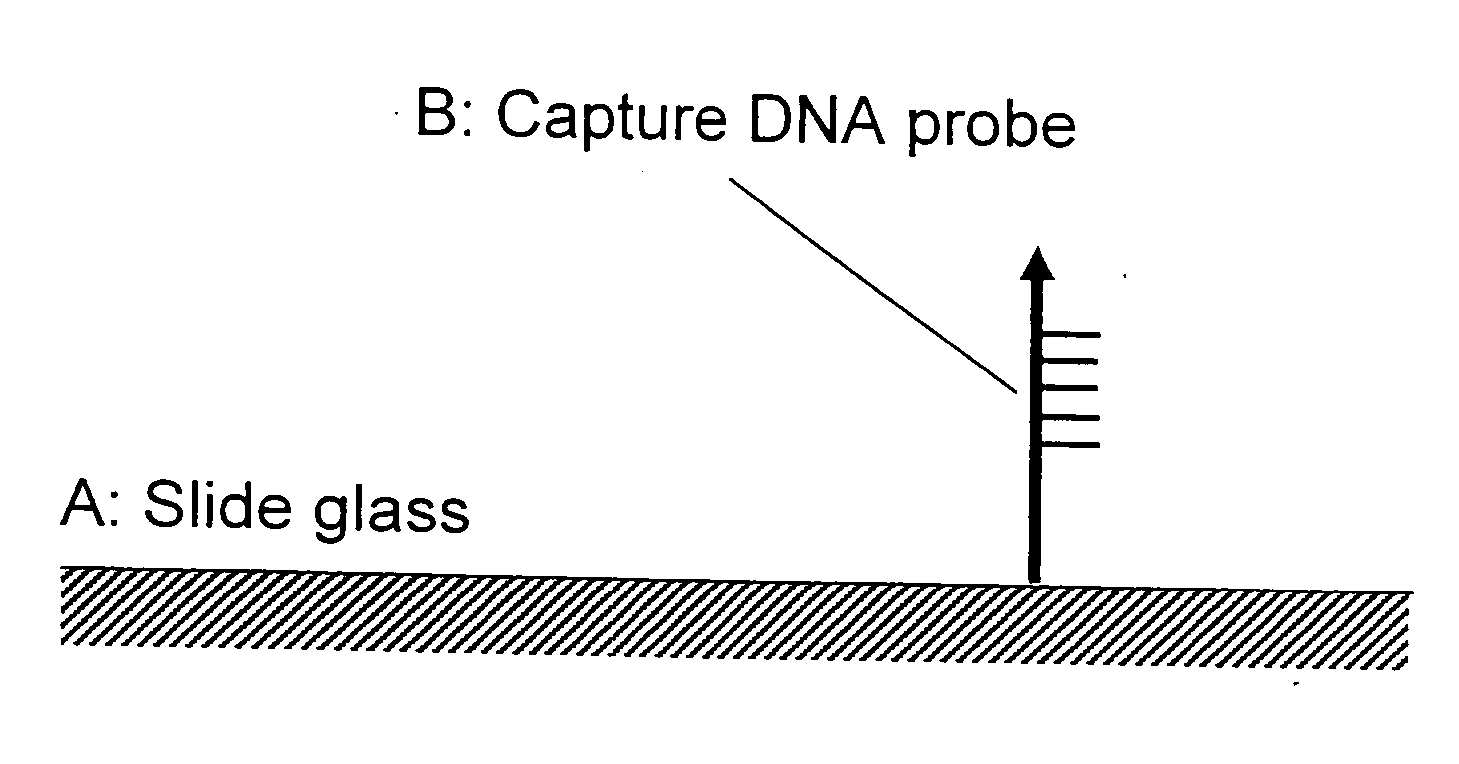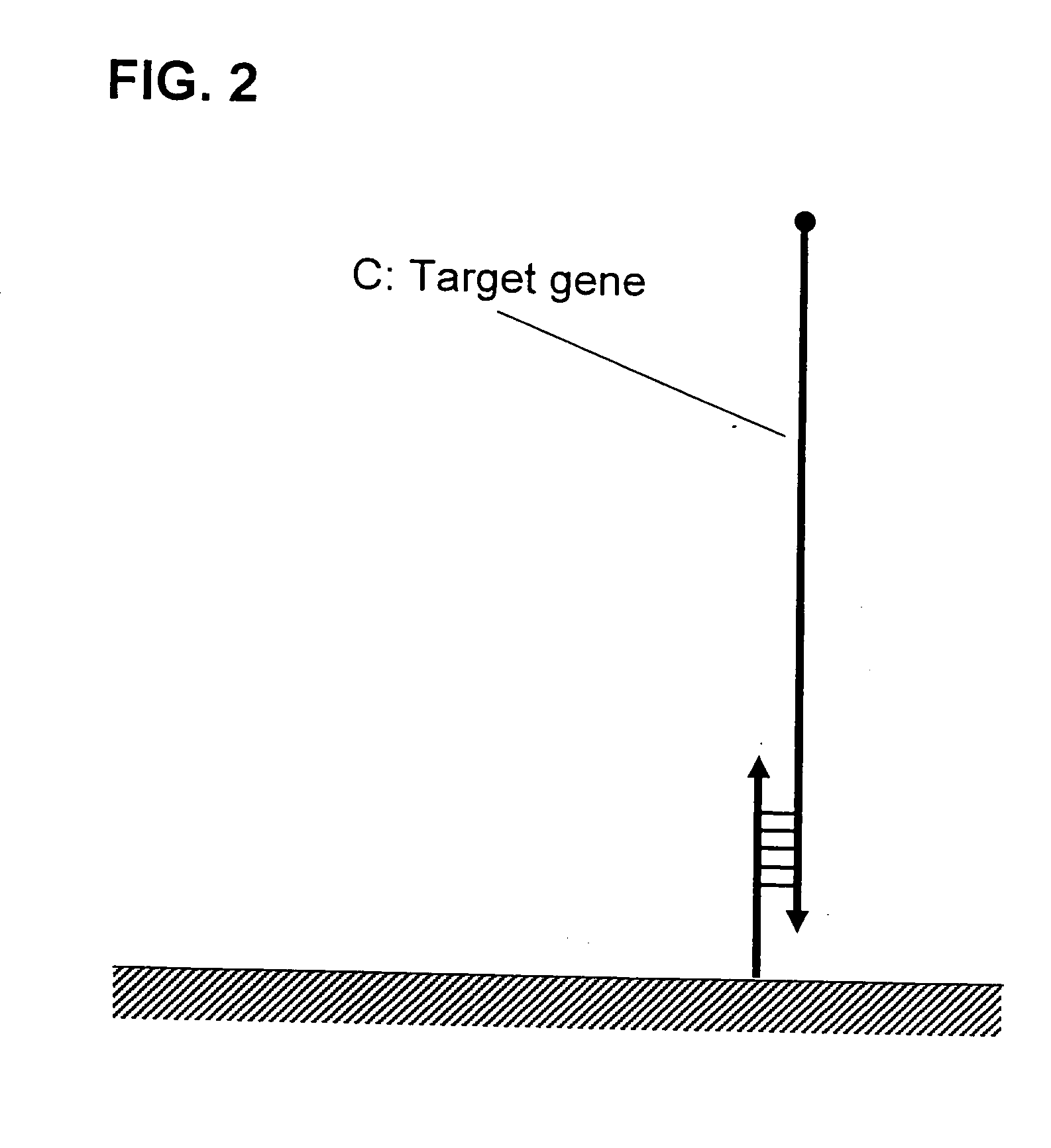Method f amplifying dna chip signals
a dna chip and signal technology, applied in the field of signal amplification methods for dna chips, can solve the problems of high cost and complicated operations, and achieve the effect of improving the sensitivity of detection of a target gene and simple detection
- Summary
- Abstract
- Description
- Claims
- Application Information
AI Technical Summary
Benefits of technology
Problems solved by technology
Method used
Image
Examples
examples
[0059] The present invention will hereinafter be described in more specific manner by way of the following examples which should be construed as illustrative rather than restrictive.
1. Materials
[0060] The following are oligonucleotide-probes used in the examples:
[1] Probe 1; Capture DNA probe-1a5′-NH2-AAAAAAGCGG GAAATCGTGC GTGACATTAA-3′[2] Probe 2; Target gene-15′-CGTGGCCATC TCTTGCTCGA AGTCCAGGGC GACGTAGCACAGCTTCTCCT TAATGTCACG CACGATTTCC CGCTCGGCCG-3′[3] Probe 3; HCP-15′-CCTGGACTTC GAGCAAGAGA TGGCCGGCAC CACCATGTACCCTGGCATTG GTCCACCGCA AATGCTTCTA GGCGG-3′[4] Probe 4; HCP-25′-GGCCATCTCT TGCTCGAAGT CCAGGCAATG CCAGGGTACATGGTGGTGCC CCGCCTAGAA GCATTTGCGG TGGAC-3′[5] Probe 5; HCP-35′-CCCTGGACTT CGAGCAAGAG CGTGGACATC CGCAAAGACCGCAGGAGTAT GACGAGTCCG-3′[6] Probe 6; HCP-45′-CTCTTGCTCG AAGTCCAGGG GGTCTTTGCG GATGTCCACGCGGACTCGTC ATACTCCTGC-3′[7] Probe 7; Dimer-forming probe-15′-GACTTCGAGC AAGAGATGGC CCTGATAGGG TGCTTGCGAGCCATTGGCAA TGAGCGGTTC-3′[8] Probe 8; Dimer-forming probe-25′-GAGCATCCC...
examples 1 to 3
[0063] a) As a capture probe, the capture DNA probe-la having a region complementary to the target gene-i and prepared at 500 ng / μL (Example 1), 50 ng / μL (Example 2), or 5 ng / μL (Example 3) was used, respectively.
[0064] b) As a primary hybridization solution, 50 ng of the target gene-1 was dissolved in 10 μL of the hybrid solution, followed by heating for 2 minutes at 95° C. to prepare a primary hybridization solution A.
[0065] c) As a secondary hybridization solution, 25 pmoles of Cy3-labeled HCP-1 and 25 pmoles of Cy3-labeled HCP-2 were dissolved in 10 μL of the hybrid solution, followed by heating for 2 minutes at 95° C. to prepare a secondary hybridization solution A.
examples 4 to 6
[0075] a) As a capture probe, the capture DNA probe-1a prepared at 500 ng / μL (Example 4), 50 ng / μL (Example 5), or 5 ng / μL (Example 6) was used, respectively.
[0076] b) As a primary hybridization solution, the above primary hybridization solution A was used.
[0077] c) As a secondary hybridization solution, 25 pmoles of HCP-1 and 25 pmoles of HCP-2 were dissolved in 10 μL of the hybrid solution, followed by heating for 2 minutes at 95° C. to prepare a secondary hybridization solution C.
PUM
| Property | Measurement | Unit |
|---|---|---|
| Color | aaaaa | aaaaa |
| Electrical conductor | aaaaa | aaaaa |
| Sensitivity | aaaaa | aaaaa |
Abstract
Description
Claims
Application Information
 Login to View More
Login to View More - R&D
- Intellectual Property
- Life Sciences
- Materials
- Tech Scout
- Unparalleled Data Quality
- Higher Quality Content
- 60% Fewer Hallucinations
Browse by: Latest US Patents, China's latest patents, Technical Efficacy Thesaurus, Application Domain, Technology Topic, Popular Technical Reports.
© 2025 PatSnap. All rights reserved.Legal|Privacy policy|Modern Slavery Act Transparency Statement|Sitemap|About US| Contact US: help@patsnap.com



